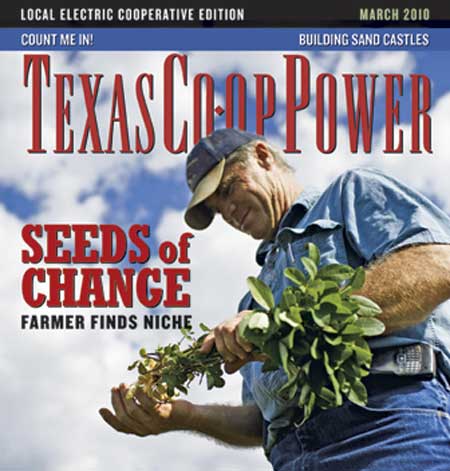
Seeds of Change: Texas Farmer Finds Niche with Wine Grapes
in Texas Co-op Power – Article on Texas High Plains grape growing at Bingham Family Farm and Vineyards. Wine grapes make good sense of Texas farm diversification and economic development
By Jody Horton
——————–
It’s mid-August, and harvest could be any day now—even today. Cliff Bingham has called viticultural consultant Bobby Cox to the vineyard for an inspection. They walk into a row of Vermentino*. The grapes are heavy and full on the vine, and the men are giddy like children. They rush from one section to the other and pull back leaves to inspect the fruit. Bobby occasionally bursts into a sudden peal of laughter from pure joy.
Cliff plucks a grape and rolls it on his palm to separate the meat, seed and skin. He explains that each can be studied to determine ripeness. “When the seed is brown, the grape has reached maturity, and it tastes nutty,” Cliff says, then crunches a seed.
Bobby squeezes the juice from one grape onto the end of a small metal cylindrical instrument called a refractometer. He holds this up to the sun and looks through an eyepiece at the other end. Sugar level, counted in Brix, is measured by the angle of refraction of light passing through the juice. After a few tests it’s determined that sugars are just under the optimum threshold along the row. “Just a few more days,” Bobby concludes.
Here on the High Plains near Meadow, 30 miles southwest of Lubbock, farming is about as good as it gets in Texas. Semi-arid and 3,333 feet above sea level, the growing season is less brutal than in many other regions in the state. Mornings are often cool, and temperatures can dip into the low 60s, even in August. Low humidity also means little possibility of fungus for crops and a reduced chance of insect infestation. But the lifeblood of the region is the Ogallala Aquifer—a vast underground water table that stretches from here to South Dakota and supplies about 30 percent of the groundwater used for irrigation in the United States. [VintageTexas: But, will it last…see the rest of the story below.]
More at: http://www.texas-ec.org/texascooppower/current_month/system/feature1.aspx
*Vermentino – The grape variety reported by some to be identical to the Rolle vinifera variety. This named grape is famously grown on the terraced vineyards of the Liguria (Riviera) coastline Cinque Terre DOC region of Italy. Also widely grown in northern Sardinia and in Corsica. It is usually used to produce full-bodied, aromatic varietal, or blended, dry white wines that go well with sea-food. Also found in the Languedoc-Roussillon region of France, Spain, Greece, E. Europe and Australia. Best when young. Now grown and rapidly becoming one of Texas’ lead varietal wine grapes.
—————
Editor’s note: This is the second in our three-part series on redefining the family farm for the declining number of Texans who choose to make their living off the land. Family farming, in the span of just a few generations, has gone from the dominant way of life to one that has nearly vanished. In this special series, “Seeds of Change—Texas Family Farms,” we meet three Texas farmers whose stories offer a glimpse of what it takes to run a family farm in 21st-century Texas.

The writer did a great job of capturing the raw excitement of inspecting a vineyard heavy with fruit in a year when most white grapes were frosted and had a very small crop if any at all. The quality? Pull a cork and see for yourself. This dog will hunt.